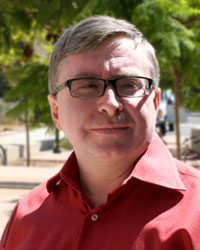

 Skip to navigation
Skip to navigation
Site Primary Navigation:
- About SDSC
- Services
- Support
- Research & Development
- Education & Training
- News & Events
Search The Site:

Published 08/20/2010

|
Norman, a distinguished professor of physics at UC San Diego and a globally recognized computational astrophysicist, had been SDSC's interim director since July 2009 and chief scientific officer of the supercomputer center since June 2008.
"Dr. Norman has demonstrated the vision and leadership the SDSC needs as we enter an era of daunting challenges, accelerating changes, and very promising opportunities," said Senior Vice Chancellor for Academic Affairs Paul W. Drake. "We are confident that SDSC will maintain its preeminence under Mike's leadership."
"Dr. Michael Norman has moved the San Diego Supercomputer Center into broader and deeper collaborations with researchers across the university's entire research enterprise, first as Chief Scientific Officer, then as Interim Director of the center," said Arthur B. Ellis, UC San Diego's vice chancellor for research. "Mike has also been one of the architects of our campus' blueprint for research cyberinfrastructure. As the center's new director, Mike will continue to build partnerships within UC San Diego and the UC system and with research institutions nationally and globally."
In addition to serving as a key resource provider for UC San Diego and the entire UC system, SDSC has several new programs and systems at the national level. SDSC late last year won a five-year, $20 million grant from the National Science Foundation (NSF) to build and operate Gordon, the first high-performance supercomputer to employ a vast amount of flash memory SSDs (solid state drives) to help speed solutions now hamstrung by slower spinning disk technology. Slated for operation in mid-2011, Gordon should rate among the top 30 or so supercomputers in the world, capable of doing latency-bound file reads 10 times faster and more efficiently than any high-performance computing system today.
" Gordon will be ideal for tackling data-intensive problems that don't scale well on today's massively parallel supercomputers, such as the analysis of individual genomes to tailor drugs to specific patients, developing more accurate models to predict the impact of earthquakes or other natural disasters on buildings and other structures, and coupled ocean/atmospheric simulations that offer greater insights into what's happening to the planet's climate," said Norman.
In addition, Gordon will be a peer-reviewed, allocated resource on NSF's TeraGrid, and be available to any U.S. researcher. TeraGrid is the nation's largest open-access scientific discovery infrastructure.
Gordon is just one of several new systems that are either already in place or scheduled to go online next year at SDSC, one of the first such centers founded by the National Science Foundation (NSF) 25 years ago. In April SDSC deployed Dash, a smaller prototype of Gordon that gives prospective users an opportunity to explore Gordon's unique architectural features. Also in operation is the Triton Resource, a new data-intensive system featuring some of the most extensive data analysis power available commercially or at any research institution in the country because of its unique large-memory nodes. Intended for use primarily by UC and UC San Diego researchers, the Triton Resource includes a Petascale Data Analysis Facility (PDAF) designed for the analysis of very large data sets, and the Triton Computer Cluster (TCC), a scalable cluster designed as a centralized resource and a highly affordable alternative to less energy-efficient 'closet computers.'
Norman, a pioneer in using advanced computational methods to explore the universe and its beginnings, was named a senior fellow of SDSC in 2000. He also directs the Laboratory for Computational Astrophysics, a collaboration between UC San Diego and SDSC resulting in the widely-used ENZO community code for astrophysics and cosmology simulations on parallel computers.
Norman is the author of over 250 publications in diverse areas of astrophysical research, including how the first stars in the universe formed and the nature of astrophysical jets. Norman's work has earned him numerous honors, including receiving Germany's prestigious Alexander von Humboldt Research Prize, the IEEE Sidney Fernbach Award, and several HPC Challenge Awards. He also is a Fellow of the American Academy of Arts and Sciences, and the American Physical Society. He holds a B.S. in astronomy from Caltech, an M.S. and Ph.D. in engineering and applied science from UC Davis, and completed his post doctoral work at the Max Planck Institute for Astrophysics in Garching, Germany, in 1984.
From 1986 to 2000, Norman held numerous positions at the University of Illinois in Urbana-Champaign, including professor of astronomy from 1991 to 2000. Norman also served as an NCSA associate director and senior research scientist under Larry Smarr, currently UC San Diego's director of the California Institute for Telecommunications and Information Technology (Calit2). Prior to that, he was a staff member at Los Alamos National Laboratory from 1984 to 1986.
About SDSC
As an organized research unit of UC San Diego, SDSC is a national leader in creating and providing cyberinfrastructure for data-intensive research. Cyberinfrastructure refers to an accessible and integrated network of computer-based resources and expertise, focused on accelerating scientific inquiry and discovery. SDSC is a founding member of TeraGrid, the nation's largest open-access scientific discovery infrastructure.
Media Contacts:
Jan Zverina, SDSC Communications
858 534-5111 or
jzverina@sdsc.edu
Warren R. Froelich, SDSC Communications
858 822-3622 or
froelich@sdsc.edu
San Diego Supercomputer Center (SDSC):
http://www.sdsc.edu/
Laboratory for Computational Astrophysics:
http://lca.ucsd.edu/portal/
National Science Foundation:
http://nsf.gov/